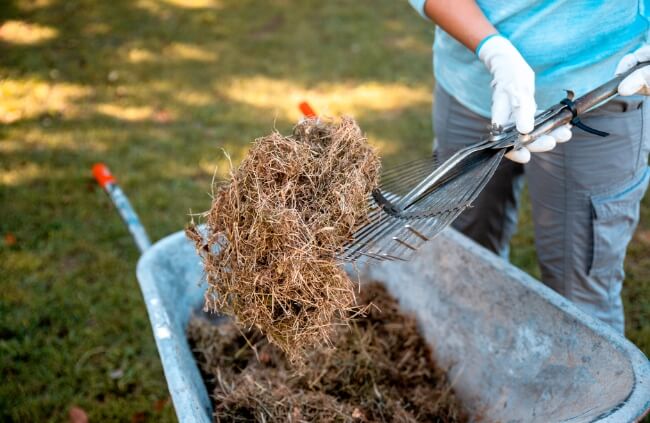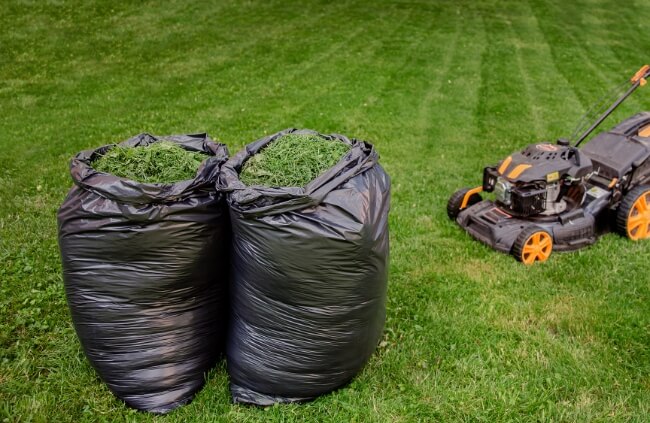Using grass clippings as mulch is one of the most effective ways to put used-up nutrients back into your soil. Although it can take longer for grass clippings to break down than compost, there are benefits to that, including prolonged moisture retention, and less nutrient loss in the composting cycle.
It’s important to understand precisely why things work in our gardens, not just whether they do or don’t. So, in this guide, I want to share some tips from around our own plot and focus on exactly why grass clipping makes good mulch.
More...
Why Use Grass Clippings as Mulch?

The most appealing reason to use grass clippings as mulch is cost. It’s a completely free source of nutrition and will help to condition your soil. It’s not as decorative as bark chips, or even rotted manure, but its slow, warm decomposition has several key benefits for plants in all seasons.
You’ll also be reducing your garden waste when you use grass clippings as mulch. If you don’t have space to compost and tend to throw cuttings and clippings in your council bin, think again.
Grass clippings can be used as mulch straight away, so there’s no need to store them, and they eventually offer just as much goodness as compost.
What does mulching do for soil?
Mulch is anything that covers your soil. In most cases, that mulch will also help to feed the soil, activate locked nutrients, and improve soil structure.
Some mulches, like pebbles and slate, are mostly decorative, but offer some weed prevention too, while many, like woodchip and shredded bark, are most effective at moisture retention through summer, before breaking down in the second and third year to act as a soil improver.
The Science Behind Mulching with Grass Clippings
Grass clippings are an effective mulch, but what is it that makes them so useful? Well, it’s a mix of a few factors. Firstly, grass clippings feed your garden.
They are high in nitrogen; a fine, fibrous food source for worms, so easily incorporated into soil; heavily moisture retentive; and they provide heat while they decompose – even through winter.
Grass Clippings Add Nutrients
Grass is a high nitrogen feeding plant, but it develops no woody growth, and if left to die back 25% of that nitrogen is simply passed back into the soil. When you cut grass, every blade is a high source of accessible nitrogen that can be added to the rest of the garden
Grass Clippings Retain Moisture
Whether you use your grass clippings fresh or dried, they will help to lock in moisture through late spring and summer.
A mulch of around 3” of fresh or dried grass clippings around the base of your hedges will massively reduce how often you need to irrigate your garden’s structural plants.
It works by preventing evaporation but providing a porous layer that any rain can pass through. Soil and any roots near the surface are protected from the baking sun, and moisture loss is vastly reduced.
Grass Clippings Improve Soil
Because grass clippings are fine and fibrous, they are easily incorporated into the soil by worms and partly decomposed by woodlice and other shade-loving insects before the worms get there.


Get Your Free Guide:
Master Growing Australian Natives eBook
A Must Have Complete Guide for Every Australian Garden
Get Your Free Guide:
Master Growing Australian Natives eBook
A Must Have Complete Guide for Every Australian Garden
In terms of making your own quick compost, there is nothing faster than fresh grass clippings, that get to work right away and aid soil structure as worms work their way through compacted or sandy soils, leaving a wake of processed worm castings behind to aerate and drain the soil too.
When to Use Grass Clippings as Mulch
Simply mounding your grass clippings around hardy shrubs like roses or raspberries helps them at all times of year, and layering grass clippings over veggie beds in winter heats up the soil and begins to replenish nutrients your harvest has removed last year.
Depending on what you need to achieve, you can use grass clippings as mulch at any time of year, but some uses have more benefits in different seasons.
How to Use Grass Clippings as Mulch
There are plenty of ways to use your grass clippings as mulch. I like to use them directly from the mower bag, but it’s equally possible to create more versatile compost from them or dry them out to provide a protective layer that won’t heat up your soil too much.
Using Dried Grass Clippings as Mulch

After cutting your lawn, make a simple pile of grass clippings, no taller than 30 cm, and spread out as wide as necessary. Leave it for a week or two, until it has browned off, and most of the moisture has dissipated or drained off.
The longer you leave your grass clippings, the more they will have decomposed when you mulch with them, and the less heat they will produce at the base of your plants. This can have positives and negatives.
Dried grass clippings should ideally be applied as a 2-3” layer, and are ideally suited to summer use, as they retain moisture in the soil and support soil activity beneath them too. The fact they are already partly dried reduces the risk of excessive humidity at the base of woody plants too (thus limiting potential fungal problems).
How to Use Fresh Grass Cuttings as Mulch
Fresh grass clippings are a more specialist mulching material, and while fresh clippings are harder to come by in winter, late autumn clippings can offer constant heat from garden beds through winter.
Not only does it offer an insulating layer against frost, but grass mulch actually heats up as it rots down. This can be useful for some plants, but not others. Tender herbaceous plants that don’t enjoy wet winters should never be mulched in winter, and fresh grass clippings should already be kept about 10 cm away from the neck of a plant to avoid rot caused by humidity.
Other Ways to Use Grass Clippings

As well as mulching with grass clippings you can use them to produce an effective compost. It won’t have the same structure as mixed compost but will rot down to a fine hummus if regularly turned over.
This hummus can be used to mulch, dug through poor soil, and even planted directly into.
Composting
To compost your grass clippings, make a simple compost pile, or build a compost bin no wider or deeper than 1.5m. This size allows for good aeration and means worms can work through the compost without the centre of the pile stagnating.
Turn your grass clipping compost at least once a fortnight, and within about four months you’ll have gorgeously fine compost, ready to use anywhere in the garden.
Alternatively, go for a more typical compost mix, with grass clippings making your nitrogen layer, and add equal amounts of dried leaves or shredded paper for more of a general soil improver.
Trenching
Legumes love any fresh nitrogen-rich materials. Digging a simple trench, about 1 ft deep, and filling the base with grass clippings offer the perfect start for beans in particular. The heat from subsurface decomposition in early spring or even late winter can offer a few extra weeks of growing time.
Instant Lawn Feed
If all of this seems like a lot of trouble to go to, there is an even easier way to use your grass clippings. Provided you cut your lawn at least weekly, and don’t let it get too long, you can simply remove the bag from your mower and let the fine clippings fall straight back down onto the grass.
Contrary to some reports, this does not increase thatch (the layer of roots below grass blades) and will rot down pretty quickly to add nitrogen back into the soil, as well as aerate topsoil naturally.
Mulching with Grass Clippings FAQs

How thick should a grass clipping mulch be?
Grass clipping mulches should be spread in 2-3” thick layers. Thicker layers can become sodden and create damp conditions for plants, and thinner layers don’t have much impact on soil improvement.
How long does it take grass clippings to decompose?
Grass clippings in a thin layer will decompose and incorporate into soil in just a couple of weeks. Thicker mulches will take a few months to fully rot down.
Do grass clippings make the soil acidic?
Grass clippings do make soil more acidic at a very minor level due to the release of ammonia during decomposition.
What are the problems with using grass clippings as mulch?
The main problem to avoid when using grass clippings as mulch is seeding. If your lawn has flowered and has seed heads, don’t use it as mulch. The seeds will drop and germinate in your borders and are a nightmare to remove.
Start Using Grass Clippings as Mulch
Mulching with grass clippings is so easy and adds so much back into our gardens that I don’t know why more people don’t do it. There is simply no faster or quicker method of producing soil-improving mulch.
As long as you’ve got a lawn, you’ve got the materials to get started to have a go at using grass clippings as mulch this year. You’ll love the results.
Published on October 26, 2023 by Gary Clarke
Last Updated on September 20, 2025




